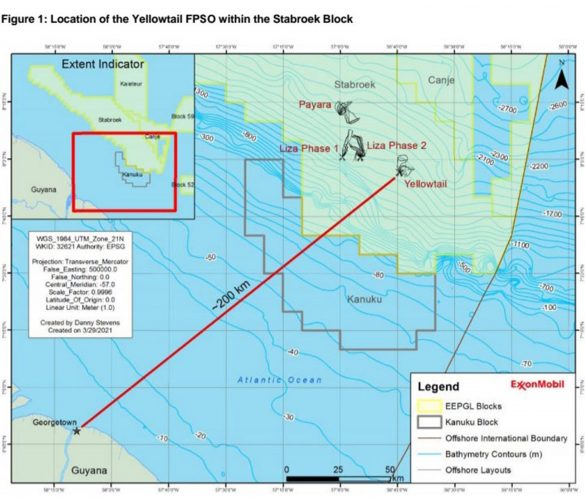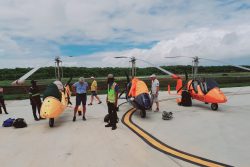The Yellowtail development in the Stabroek Block, approximately 126 miles offshore Guyana, is the fourth project being undertaken by ExxonMobil and its partners and it is the first development that the Government of Guyana is pushing for specific oil spill insurance on.
The Liza-1, Liza-2 and Payara developments were approved and developed without an agreement on oil spill insurance between the government and Exxon’s local affiliate, Esso Exploration and Production Guyana Limited (EEPGL). Guyana currently pumps an average of 124,000 barrels of oil per day and should there be a mishap in the process and oil spills into the Atlantic, then there is no specific insurance policy to cover response efforts.
On Thursday night during a virtual consultation on the Yellowtail Project, Head of the Environmental Protection Agency (EPA) Kemraj Parsram told the gathering that insurance would be covered in accordance with the Environmental Protection Act of Guyana.

“I am making sure that we are comfortable before we sign the documents so I’m going through all the hoops to make sure this is an agreement we are all comfortable with. The insurance as provided for in the Environmental Protection Act, that’s what we will be looking at. There is financial assurance as stated in Environmental Protection Act, and that’s what we will follow,” he explained.
Section 30 of the Environmental Protec-tion Act states that “financial assurance” can mean cash, in an amount specified in the environmental authorisation; a letter of credit from a bank with a specified amount; a guarantee from any person whose long term unsecured obligations are rated equally with a bank by an internationally recognised credit rating agency; or a performance bond with a specified amount.
With respect to financial assurance, the Act states that the EPA may include, in any environmental authorisation, a requirement that the recipient of any environmental authorisation shall provide financial assurance to the state for a number of reasons.
Section 31 of the Act lists some of the reasons as “the performance of any action or compliance with any condition specified in any environmental authorisation; the provision of alternate water supplies to replace those that the Agency has reasonable grounds to believe are or likely to be contaminated or otherwise interfered with by the works to which the environmental authorisation relates; measures appropriate to prevent adverse effects upon and following the cessation or closing of the works.”
The EPA, under the Act, is required to specify the amount of financial assurance to be provided by the body receiving the environmental authorisation. Additionally, the Act empowers the Minister of Natural Resources and the Environment to issue regulations in relation to the circumstances under which financial assurance must be required by the EPA, the terms and conditions of the financial assurance and the effect of failure to provide financial assurance.
Vice President Bharrat Jagdeo, who is the government’s spokesperson on the environment, recently announced that the government is mulling a US$2 billion insurance policy from Exxon.
Parsram told Thursday night’s gathering that they are working to have an agreement sealed at the earliest time possible.
“The EPA is currently reviewing and in negotiations with the EEPGL and plus we’re having our legal minds in Guyana as well as the Ministry of Natural Resources to review the draft agreement on and the contents therein. I’m working assiduously and I’m just waiting for feedback from the legal minds. I recently reached out to the Ministry of Natural Resources and their team to provide your feedback. I’m sending it to the AG Chambers for review as well. I’m hoping to wrap this up as soon as possible. So as soon as I’m comfortable with the agreement, then I will sign and have them sign,” he said.
Additionally, he said that the EPA is currently finalizing an independent review of the EIA for the Yellowtail development and the review from there coupled with recommendations provided by the public consultations and Environment Assessment Board (EAB), will determine whether approval is granted or not.
Jagdeo’s announced US$2 billion liability insurance is the same amount that was proposed by ExxonMobil to and rejected by the former head of the EPA, Dr Vincent Adams. He had pressed for unlimited liability coverage from the parent companies since one oil spill had cost over US$60 billion.
During an earlier interview with the Stabroek News, Dr Adams had said that during his tenure as Executive Director of the EPA, two changes were made to the permit for the Exxon-led Liza-2 development to have the parent company stand the liability instead of EEPGL.
“Even though it was written into the permit that the parent corporation is going to cover the liability, they went out for insurance for US$2.5 billion and we said that it’s not going to do and the parent companies have to have coverage for everything over and above, so it’s an unlimited liability coverage. Well, guess what? It’s been over a year now and they have not signed the document from the parent companies saying that they are going to go ahead. We had several meetings with them, with our lawyers present and so questions need to be asked from the government about what is going on with the signing of that guarantee for unlimited coverage that the company [EEPGL] had agreed to in the past,” Adams had said before adding that even though it is part of the environmental permit, EEPGL has not signed the document that guarantees this.
As part of the Yellowtail, Project ExxonMobil plans to drill between 40 and 67 wells for the 20-year duration of the investment. It is intended to be the largest of the four developments with over 250,000 barrels of oil per day targeted once production commences. Based on the schedule, once approval is granted, engineering commences in 2022 and production in the latter part of 2025.
According to the EIA, in addition to Guyana, some 11 Caribbean and South American territories can be affected should there be a spill offshore Guyana. The issues of transboundary insurance and consultations have been raised. (Lakhram Bhagirat)









